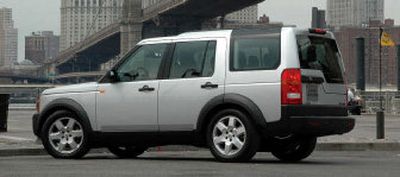LR3 shows how smooth an SUV can be

In its new LR3, Land Rover has a midsize luxury sport-ute worth getting excited about.
The LR3 replaces the Discovery, which had foundered on the shoals of suspect reliability, questionable performance and stiff competition.
You’d have thought Land Rover would have the luxury sport-ute thing nailed. It invented the form with the noble Range Rover, choice of Britain’s adventurer class, champion of the Serengeti.
Until now, though, Land Rover had been unable to duplicate the Range Rover’s success in the all-important midsize category.
The Discovery had carried on the company’s tradition of grand off-roading and sold well in its first years of production. But new, high-end, midsize rigs from the likes of Mercedes-Benz and BMW eclipsed it for usability, durability and performance.
Backed by the deep pockets of corporate parent Ford, Land Rover worked from a clean sheet on the LR3, which is called Discovery 3 abroad. They gave it a longer wheelbase and more overall length for increased interior space and improved ergonomics, brewed up some suspension wizardry, and found room under the hood for a V-8 from the Jaguar parts bin (Jaguar is another Ford subsidiary).
They must also have renewed contracts with their leather suppliers, as the LR3 is awash in cowhide.
The LR3 received seating for five and an optional third row to bump the total to seven.
Perhaps most important, Land Rover made sure its newest product was as capable on-road as off, and vice versa. If it’s smooth sailing between you and where you want to be, the LR3 will get you there in style and comfort. If there’s a cliff in the way, you might work up a sweat.
To accomplish this feat, Land Rover developed an innovative structure for the LR3. The off-road crowd prefers the strength of body-on-frame construction to unibody structure found in sedans and crossover SUVs. In effect, unibodies absorb the frame into a one-piece structure that encloses and strengthens the cabin. A unibody can be made very stiff, which reduces squeaks and rattles and makes it possible to tweak the suspension settings for the best possible ride and handling package.
Land Rover split the difference with a new structure, called a “body-frame,” which integrates a frame into the body. Its downside is weight, but it allows engineers to build in off-road capabilities without impacting control or passenger comfort.
Because they offer superior suspension travel and wheel articulation, purists like a solid rear axle under their rigs. Land Rover went with an all-independent control-arm setup and claims it equals the Discovery’s wheel articulation and betters its suspension travel.
The four-wheel-drive system is in full-time operation and a two-speed transfer case and locking center differential improved traction in difficult situations. A locking rear diff is available.
The LR3’s piece de resistance is its unique Terrain Response system.
Using a small knob on the center console, the driver selects one of five settings: general (for everyday driving); grass/gravel/snow; mud and ruts; sand and rock crawl. Based on the mode, the LR3 alters throttle response, the shift algorithms, the timing of the pulses the anti-lock brakes produce, the traction and stability control systems and the locking action of the differentials.
Those who have tested the system on the proving grounds say it works like a champ.
Another space-age software system, called “active roll mitigation,” is programmed into the air suspension to minimize body lean during corners and the hairier moments on the trail. Its longer wheelbase and wider track give the LR3 a built-in advantage over the Discovery; add active roll mitigation and it feels rock-solid in all types of lean-provoking situations.
The LR3 weighs 5,686 pounds, so a serious power plant was tapped for the job, a 4.4-liter V-8 that makes 300-hp, 83 more than the Discovery and 18 more than the existing, full-size Range Rover.
The bored-out Jag mill makes 315 pound-feet of torque, which comes in handy when crawling up steep, rock-strewn slopes.
Accompanied by a six-speed ZF automatic transmission, the eight sprints from 0 to 60 in 8.3 seconds, which betters the Discovery by some 2 seconds.
A 4-liter, 216-hp V-6 just arrived in dealerships. It makes 269 pound-feet of torque.
Neither engine is thrifty: the eight makes 14 city/18 highway, the six 14/19.
No one mistakes the LR3 for anything but a Land Rover. It retains the upright stance and airy greenhouse of the Discovery, but its body has been rounded off around the corners and presents an altogether softer face.
In the fashion of the Range Rover, the LR3’s interior is all business, but displays considerably less opulence. Its leather-wrapped seats cry for a wood-paneled dash, or at least some chrome bits, but Land Rover went with functionality the whole way.
The rear doors are wide enough to allow graceful ingress and egress and the air suspension can be dropped to its lowest setting to help. Seats are supportive and firm and a nine-speaker harman kardon audio system cranks out the tunes. There are cup-holders galore and bottle-holders in the door panels. An optional cooler fits inside the console.
Even the third-row seats are habitable by adults, and come with extended curtain airbags. All rear seats may be folded down independently to increase cargo capacity to either 87.4 or 90.3 cubic feet, depending on the configuration.
Standard gear on even the entry-level models (from $38,285, including destination) includes leather seats, stadium seating, dual-zone climate control and the h-k audio system with a six-disc CD changer.